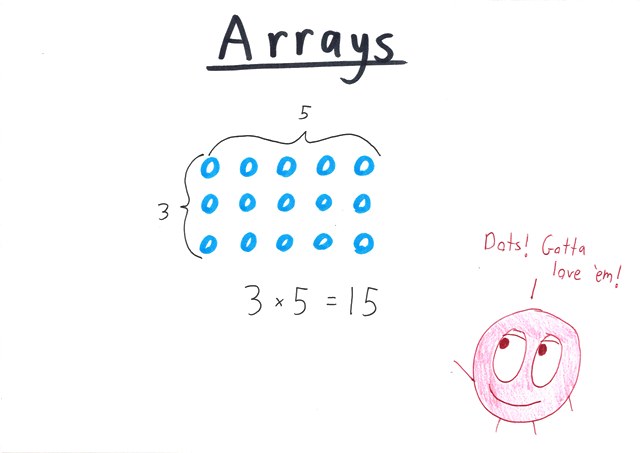In this case, the drawings are great, as is the commentary. Lately I’ve been seeing headlines such as “Parents go Back to School with the Common Core” and “Teachers Teaching Math to Students and Their Parents”; I wonder about the vanilla extract analogy at the end of this post. Is it really too late for math-challenged parents? I’d like to say no, but then again I occasionally have college students with a poor grasp of these concepts. Of course it may be easier to hear “come see what math your kids are working with” than “your calculus problem is actually an arithmetic problem; you need to go back to fifth or sixth grade math.”
Or, Seeing Arrays (Less Cinematic Than Seeing Dead People, But More Useful)
This year, I’m teaching younger students than I’ve ever taught before. These guys are 11 and 12. They’re newer than iPods. They watched YouTube before they learned to read.
And so, instead of derivatives and arctangents, I find myself pondering more elemental ideas. Stuff I haven’t thought about in ages. Decimals. Perimeters. Rounding.
And most of all: Multiplication.
It’s dawning on me what a rich, complex idea multiplication is. It’s basic, but it isn’t easy. So many of the troubles that rattle and unsettle older students (factorization, square roots, compound fractions, etc.) can be traced back to a shaky foundation in this humble operation.
What’s so subtle about multiplication? Well, rather than just tell you, I’ll try to show you, by using a simple visualization of what it means to multiply.
Multiplication is making an array.
View original post 632 more words


This really is a great exposition on an underused approach. Many of these I had already considered, but the justification for one as not prime is new to me. Of course the question arises then, why is two prime? It makes a lovely 1 x 2 array. The common divisor explanation is obvious, but I haven’t ever used it! All in all, it’s a great post. Thanks for sharing.